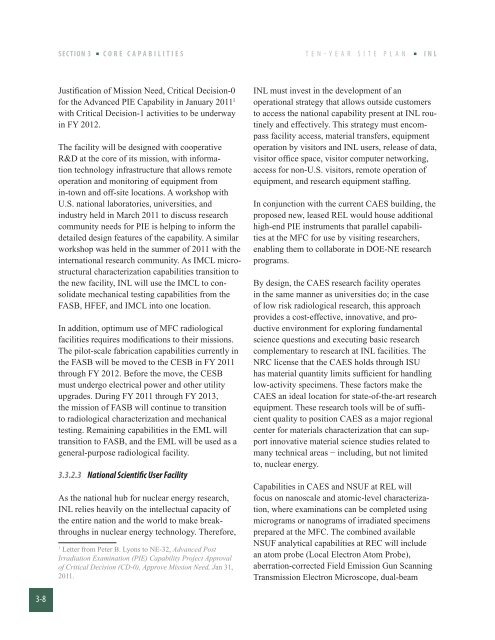2013-2022 TEN-YEAR SITE PLAN - Idaho National Laboratory
2013-2022 TEN-YEAR SITE PLAN - Idaho National Laboratory
2013-2022 TEN-YEAR SITE PLAN - Idaho National Laboratory
Create successful ePaper yourself
Turn your PDF publications into a flip-book with our unique Google optimized e-Paper software.
3-8<br />
SECTION 3 CORE CAPABILITIES<br />
Justification of Mission Need, Critical Decision-0<br />
for the Advanced PIE Capability in January 2011 1<br />
with Critical Decision-1 activities to be underway<br />
in FY 2012.<br />
The facility will be designed with cooperative<br />
R&D at the core of its mission, with information<br />
technology infrastructure that allows remote<br />
operation and monitoring of equipment from<br />
in-town and off-site locations. A workshop with<br />
U.S. national laboratories, universities, and<br />
industry held in March 2011 to discuss research<br />
community needs for PIE is helping to inform the<br />
detailed design features of the capability. A similar<br />
workshop was held in the summer of 2011 with the<br />
international research community. As IMCL microstructural<br />
characterization capabilities transition to<br />
the new facility, INL will use the IMCL to consolidate<br />
mechanical testing capabilities from the<br />
FASB, HFEF, and IMCL into one location.<br />
In addition, optimum use of MFC radiological<br />
facilities requires modifications to their missions.<br />
The pilot-scale fabrication capabilities currently in<br />
the FASB will be moved to the CESB in FY 2011<br />
through FY 2012. Before the move, the CESB<br />
must undergo electrical power and other utility<br />
upgrades. During FY 2011 through FY <strong>2013</strong>,<br />
the mission of FASB will continue to transition<br />
to radiological characterization and mechanical<br />
testing. Remaining capabilities in the EML will<br />
transition to FASB, and the EML will be used as a<br />
general-purpose radiological facility.<br />
3.3.2.3 <strong>National</strong> Scientific User Facility<br />
As the national hub for nuclear energy research,<br />
INL relies heavily on the intellectual capacity of<br />
the entire nation and the world to make breakthroughs<br />
in nuclear energy technology. Therefore,<br />
1 Letter from Peter B. Lyons to NE-32, Advanced Post<br />
Irradiation Examination (PIE) Capability Project Approval<br />
of Critical Decision (CD-0), Approve Mission Need, Jan 31,<br />
2011.<br />
T E N - Y E A R S I T E P L A N INL<br />
INL must invest in the development of an<br />
operational strategy that allows outside customers<br />
to access the national capability present at INL routinely<br />
and effectively. This strategy must encompass<br />
facility access, material transfers, equipment<br />
operation by visitors and INL users, release of data,<br />
visitor office space, visitor computer networking,<br />
access for non-U.S. visitors, remote operation of<br />
equipment, and research equipment staffing.<br />
In conjunction with the current CAES building, the<br />
proposed new, leased REL would house additional<br />
high-end PIE instruments that parallel capabilities<br />
at the MFC for use by visiting researchers,<br />
enabling them to collaborate in DOE-NE research<br />
programs.<br />
By design, the CAES research facility operates<br />
in the same manner as universities do; in the case<br />
of low risk radiological research, this approach<br />
provides a cost-effective, innovative, and productive<br />
environment for exploring fundamental<br />
science questions and executing basic research<br />
complementary to research at INL facilities. The<br />
NRC license that the CAES holds through ISU<br />
has material quantity limits sufficient for handling<br />
low-activity specimens. These factors make the<br />
CAES an ideal location for state-of-the-art research<br />
equipment. These research tools will be of sufficient<br />
quality to position CAES as a major regional<br />
center for materials characterization that can support<br />
innovative material science studies related to<br />
many technical areas − including, but not limited<br />
to, nuclear energy.<br />
Capabilities in CAES and NSUF at REL will<br />
focus on nanoscale and atomic-level characterization,<br />
where examinations can be completed using<br />
micrograms or nanograms of irradiated specimens<br />
prepared at the MFC. The combined available<br />
NSUF analytical capabilities at REC will include<br />
an atom probe (Local Electron Atom Probe),<br />
aberration-corrected Field Emission Gun Scanning<br />
Transmission Electron Microscope, dual-beam

















